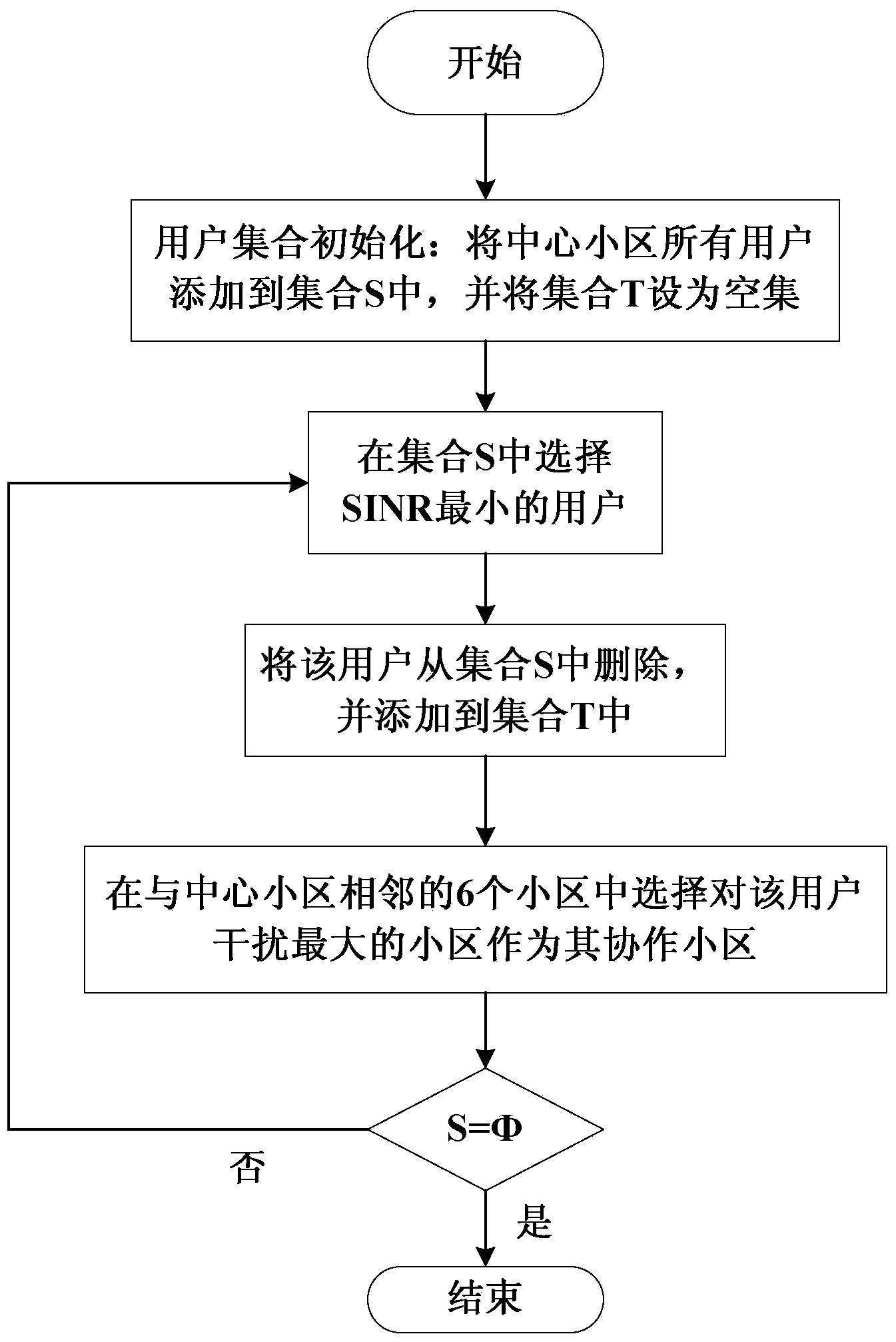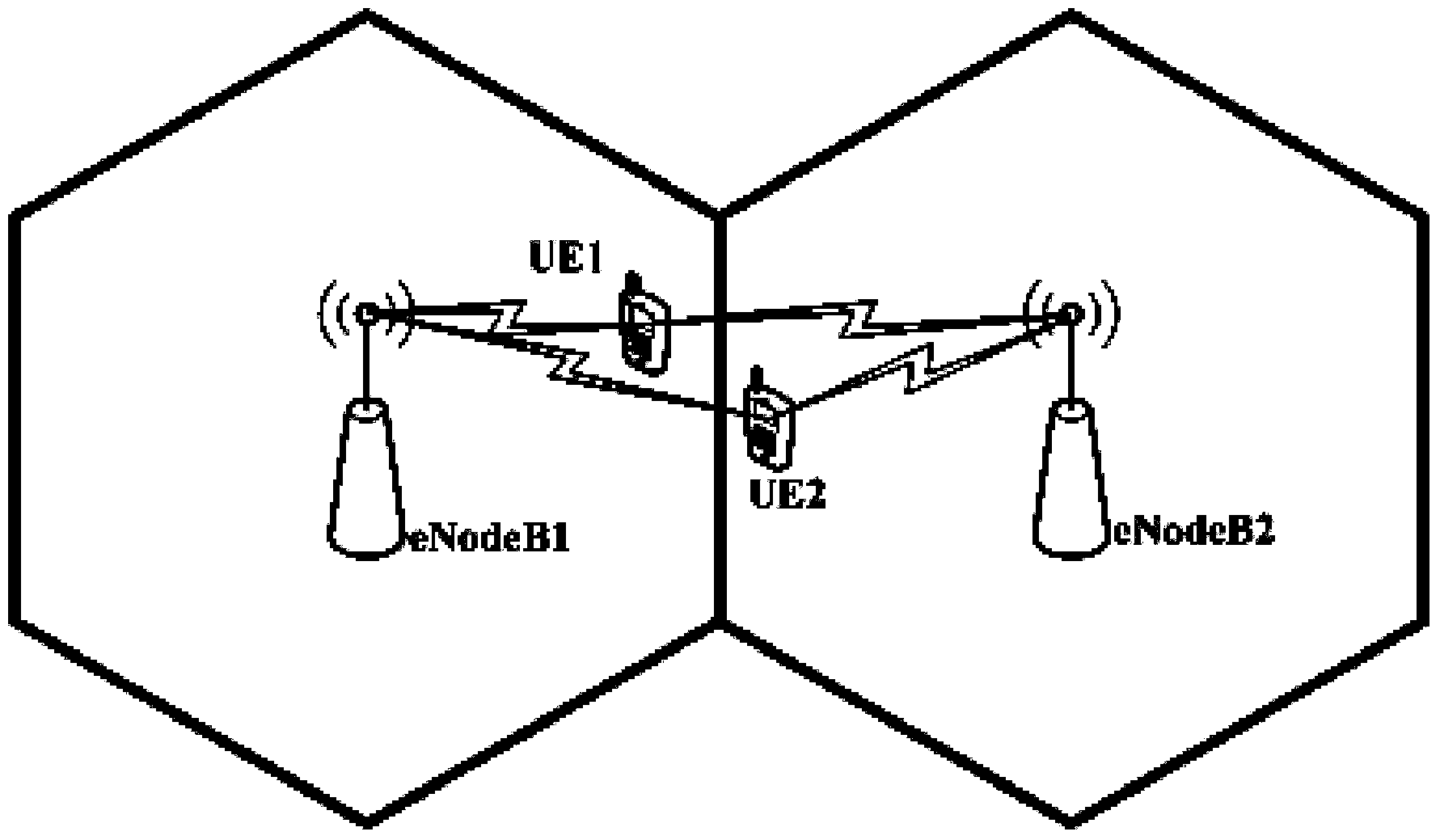Downlink CoMP (Coordinated Multi-Point) hybrid collaborative communication method based on LTE-Advanced (Long Term Evolution-Advanced) system
A cooperative communication and comp-cb technology, which is applied in the field of realization of LTE-Advanced system downlink CoMP scheme, can solve the problem of large amount of information interaction
- Summary
- Abstract
- Description
- Claims
- Application Information
AI Technical Summary
Problems solved by technology
Method used
Image
Examples
specific Embodiment approach 1
[0031] Specific embodiment one, the downlink CoMP hybrid cooperative communication method based on LTE-Advanced system, it is realized by the following steps:
[0032]Step 1. Parameter setting: set the distance between base stations, system transmission bandwidth, base station transmit power, noise power spectral density, antenna offset angle, number of base station transmit antennas, number of terminal receive antennas, number of users in each cell, size of cooperative set and Relevant parameters such as the proportion of CoMP-JP users in the cell α;
[0033] Step 2. Network generation: Generate a cellular network according to the parameters in step 1; grid the cell, calculate the distance from each location point to the base station, and obtain the cell to which each point belongs; sector angle, calculate the sector to which the point belongs;
[0034] Generate users: get the location information of the users, the cell to which they belong, the sector to which they belong, ...
specific Embodiment approach 2
[0050] Embodiment 2. The difference between this embodiment and the downlink CoMP hybrid cooperative communication method based on the LTE-Advanced system described in Embodiment 1 is that in step 4, α=0, that is, all users cooperate in CoMP-CB mode At this time, the specific steps of the downlink CoMP hybrid coordination scheme based on the LTE-Advanced system are:
[0051] Step 1. Parameter setting: set the distance between base stations, system transmission bandwidth, base station transmit power, noise power spectral density, antenna offset angle, number of base station transmit antennas, number of terminal receive antennas, number of users in each cell, size of cooperative set, etc. Related parameters.
[0052] Step 2. Network generation: Generate a cellular network according to the parameters in step 1; grid the cell, calculate the distance from each location point to the base station, and obtain the cell to which each point belongs; sector angle, calculate the sector to...
specific Embodiment approach 3
[0059] Embodiment 3. The difference between this embodiment and the downlink CoMP hybrid cooperative communication method based on the LTE-Advanced system described in Embodiment 1 is that in step 4, α=1, that is, all users cooperate in CoMP-JP mode At this time, the specific steps of the downlink CoMP hybrid coordination scheme based on the LTE-Advanced system are:
[0060] Step 1. Parameter setting: set the distance between base stations, system transmission bandwidth, base station transmit power, noise power spectral density, antenna offset angle, number of base station transmit antennas, number of terminal receive antennas, number of users in each cell, size of cooperative set, etc. Related parameters.
[0061] Step 2. Network generation: Generate a cellular network according to the parameters in step 1; grid the cell, calculate the distance from each location point to the base station, and obtain the cell to which each point belongs; sector angle, calculate the sector to...
PUM
 Login to View More
Login to View More Abstract
Description
Claims
Application Information
 Login to View More
Login to View More - R&D
- Intellectual Property
- Life Sciences
- Materials
- Tech Scout
- Unparalleled Data Quality
- Higher Quality Content
- 60% Fewer Hallucinations
Browse by: Latest US Patents, China's latest patents, Technical Efficacy Thesaurus, Application Domain, Technology Topic, Popular Technical Reports.
© 2025 PatSnap. All rights reserved.Legal|Privacy policy|Modern Slavery Act Transparency Statement|Sitemap|About US| Contact US: help@patsnap.com



